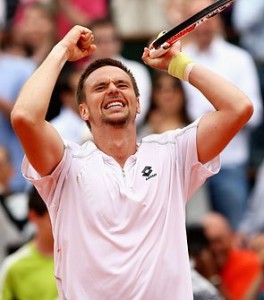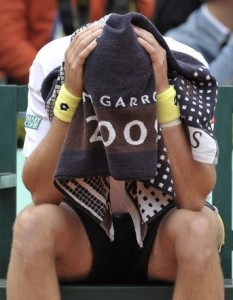How He Fared in 2009: Robin Soderling Grows Up

Soderling's victory over Nadal is considered as the biggest upset in the history of Roland Garros
One of the (dis)advantages of being a software junkie is I like to come up with weird geeky nicknames without any context, and those are not taken particularly well, especially with the fairer sex. This disappointment is usually covered up by the amusing happiness I get by basking in my own glory of false intelligence.
Robin Soderling was assigned a similar nickname when he created the greatest upset in the history of Roland Garros — BSOD — an acronym for “Blue Screen of Death ” which we often get while using a Windows Operating System. Soderling became famous after this historic match and his career has steadily progressed after this tournament, rather than being lost after a one off, which further justifies the nomenclature.
Things were not the same for this Swede, though, till he met Nadal at Phillip Chatrier.
Unlike his precedents, he does not possess the ice cool demeanor of Bjorn Borg, the adaptability of Mats Wilander, the elegance of Stefan Edberg, or the raw, but underutilized, talent of Thomas Enquist. And there is only so much that you can achieve with a big serve and a massive ugly forehand which works best only in normalized conditions under a roof.
Yet, mentally stronger people have fought and achieved much better results with even lesser talent that what Soderling had achieved till May this year.
Apart from the deficiencies in his game, Soderling lacked this inherent trait of the Swedes as well. His lack of maturity was visibly apparent either when he tried to imitate Nadal or made a fool of himself by incessantly arguing over a straight forward line call against the same player he so hates.
He might not like Nadal for the rest of his life, and this behavior was not expected from a top 20 player, but what it did prove was that Soderling never had any fear while playing against Federer or Nadal, two players who have won numerous matches by mentally defeating their opponent even before the start of the match.
And ironically it was against Nadal, who had brought out the most fragile part of his behavior, when he so effectively turned the tables and revived his ordinary year in which he was facing difficulty winning two straight matches.
To prove that the upset was no fluke, the Swede later launched a dominating victory against Nikolay Davydenko, who himself would go on to enjoy his most successful year and earned a hard fought victory against Fernando Gonzalez to reach his maiden appearance in a slam final, halted only by the person who went on to create history.
Despite his success, Soderling has not been able to solve the Federer puzzle who has beaten him 13 straight times. The heartening fact for him is he is getting closer to solve the mystery with their every meeting.
In Roland Garros, it was an easy three set defeat, which improved to a tight three set defeat at Wimbledon – Federer’s favorite surface — and after smashing the racket at the Ashe Stadium, Soderling was a completely different player who almost stretched Federer to a fifth set giving the world No. 1 his toughest competition of the tournament before Del Potro.
Much of Soderling’s success has been attributed to his coach Magnus Norman, who has not only improved his physical conditioning and his attitude on court, but added a calming influence on court. Soderling is prepared to play the waiting game of rallying long enough to create opportunities, while his famous relationship with his towel (during changeovers) has helped improved his concentration.

What does Soderling does while immersing himself into the towel which improves his concentration?
His mental strength was never more visible than in the year’s final tournament at London. In his match against Djokovic, he lost three consecutive set points but later rallied to win the first set. In the semi-finals against Del Potro he was serving dangerously at 0-40 down in the first set. Unperturbed, he fired down three aces and two service winners to win five consecutive points, saved the game, and went on to win the first set.
The rejuvenated Soderling may not be that ripe young man who can be looked forward to creating wonders in the coming years. Now 25 years of age, he does not have age on his side to win half a dozen majors, but he will surely look forward to the opening year of the next decade, where he can try to climb into top-5, or win a couple of masters shields.
A major may still seem far fetched, but then many players have won their first major in the late twenties or even the early thirties. Ask Goran Ivanisevic.
If only BSOD can reveal the secret self conversations inside his towel.
I loved as much as you’ll receive carried out right here. The sketch is attractive, your authored subject matter stylish. nonetheless, you command get got an edginess over that you wish be delivering the following. unwell unquestionably come further formerly again as exactly the same nearly a lot often inside case you shield this increase.
You need to meaning people using every clues & great tips on precisely how well you thought i would get this to web site glimpse this specific very good , I’d like it!
Can you email me with a few hints on how you made your blog look this awesome , Id appreciate it.